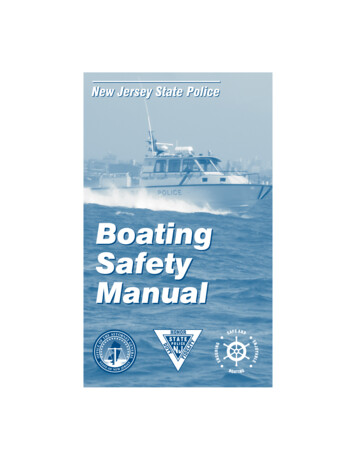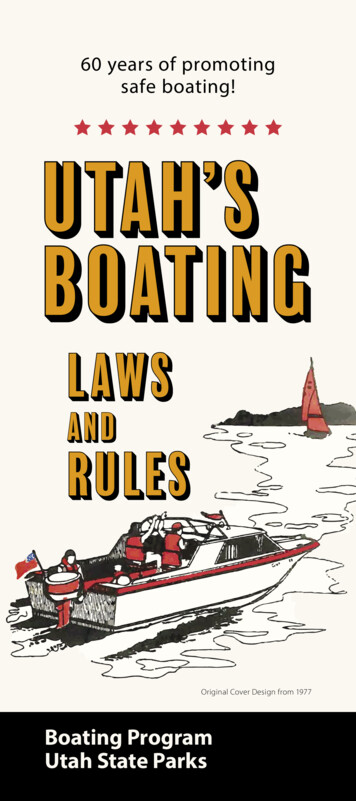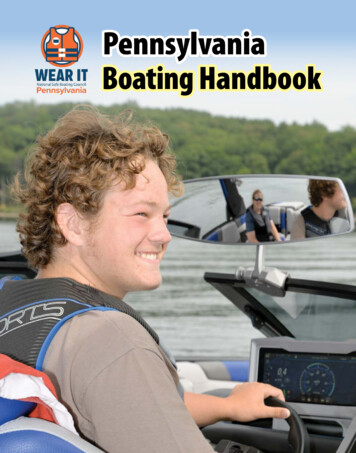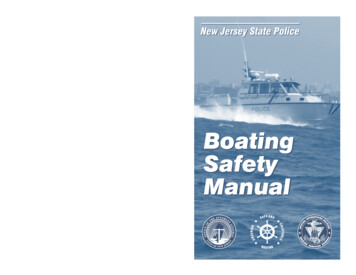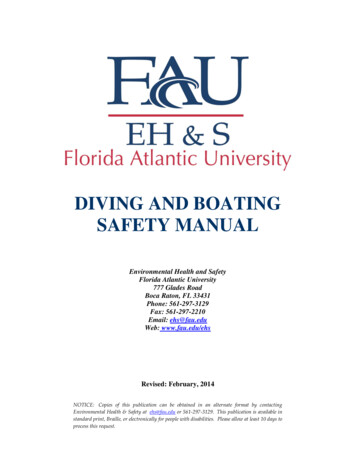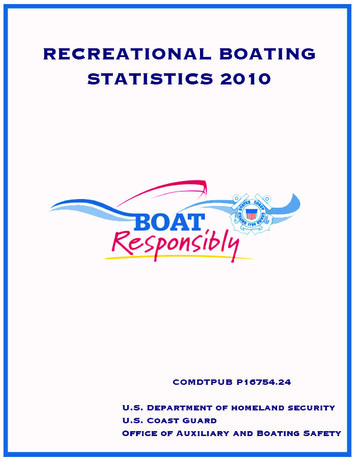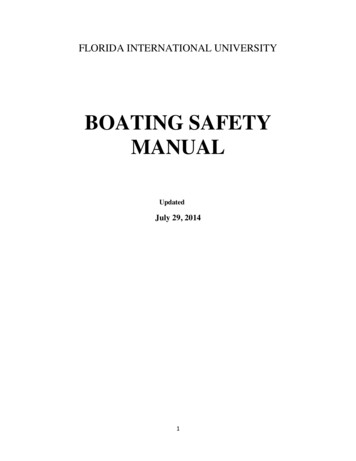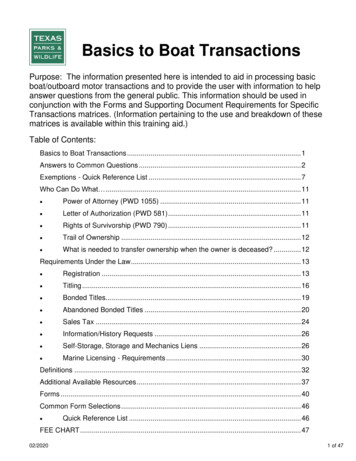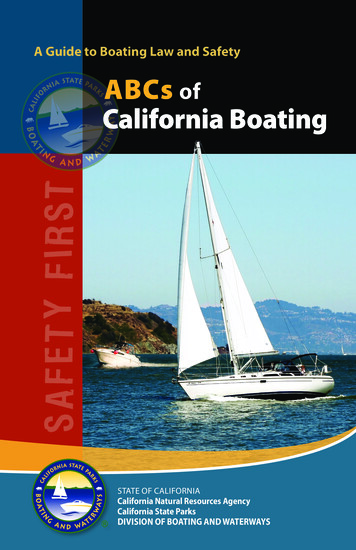
Transcription
A Guide to Boating Law and SafetySA F E T Y F I R STABCs ofCalifornia BoatingSTATE OF CALIFORNIACalifornia Natural Resources AgencyCalifornia State ParksDIVISION OF BOATING AND WATERWAYS
O W N E R / B O AT I N F O R M AT I O NOwner/Boat InformationName of OwnerCalifornia Boater Card #Name of BoatBoat CF #Personal Contact InformationOwner’s Cell PhoneOwner’s Home PhoneOwner’s Home AddressEmergency Contact InformationHome Marina PhoneHarbormaster PhoneMarine Law Enforcement PhoneOther Important Phone NumbersEmergency Phone Number – 911
A Guide to Boating Law and SafetyABCs ofCalifornia BoatingDEAR CALIFORNIA BOATER:You are among California’s four million recreational boaters who visitmarinas, lakes, rivers and the ocean seeking an enjoyable outdoorrecreational experience. In order to ensure that your experience is asafe and enjoyable one, it is important for you to know and follow theregulations and guidelines found in this booklet.The ABCs of California Boating is based upon the California Harborsand Navigation Code, Vehicle Code, Penal Code, and California Code ofRegulations, but uses everyday terms rather than legal language in mostinstances. Not all provisions of law pertaining to boating are included.Consequently, the booklet is not suitable for use in law enforcement orin litigation.This booklet is one of many resources available through the CaliforniaState Parks Division of Boating and Waterways (DBW). The divisionbrings together a body of knowledge as the state’s expert in recreationalboating-related matters, including public access, safety and education,marine law enforcement, and consumer and environmental protection.Recreational boaters provide the funding for DBW through state fuel taxespaid by boaters when gas is purchased, interest and principal repaymentof DBW loans by boating facility owners, state registration fees paid byboaters for motorized recreational boats, and license fees paid by yachtand ship brokers and salespersons.Visit www.BoatCalifornia.com to learn more about DBW and about theresources available to you.Have a safe and pleasant boating season.STATE OF CALIFORNIACalifornia Natural Resources AgencyCalifornia State ParksDIVISION OF BOATING AND WATERWAYSi
SAFETY FIRSTCONTENTSPreparationWaterway Markings6Federal Lateral System . . . . . . . . . . . . . . . . . . . . . . . . . . . . . . . 6Uniform State Waterway Marking System . . . . . . . . . . . . . . . . . . . 7Mooring to Buoys . . . . . . . . . . . . . . . . . . . . . . . . . . . . . . . . . . 8Aids to Navigation . . . . . . . . . . . . . . . . . . . . . . . . . . . . . . . . . . 9Rules of the Waterways10Navigation Rules . . . . . . . . . . . . . . . . . . . . . . . . . . . . . . . . . . 10Boater Responsibility . . . . . . . . . . . . . . . . . . . . . . . . . . . . . . . . 10Navigation Signals . . . . . . . . . . . . . . . . . . . . . . . . . . . . . . . . . 10Meeting or Crossing Situations . . . . . . . . . . . . . . . . . . . . . . . . . 11Overtaking Situations . . . . . . . . . . . . . . . . . . . . . . . . . . . . . . . 12Other Situations . . . . . . . . . . . . . . . . . . . . . . . . . . . . . . . . . . 13Rules for Sailing Vessels . . . . . . . . . . . . . . . . . . . . . . . . . . . . . . 13Fog Signals . . . . . . . . . . . . . . . . . . . . . . . . . . . . . . . . . . . . . . 14Operational LawPeace Officers . . . . . . . . . . . . . . . . . . . . . . . . . . . . . . . . . . . . 15Trailering . . . . . . . . . . . . . . . . . . . . . . . . . . . . . . . . . . . . . . . 15Stolen Vessels . . . . . . . . . . . . . . . . . . . . . . . . . . . . . . . . . . . . 15County and City Laws . . . . . . . . . . . . . . . . . . . . . . . . . . . . . . . 15Age Restrictions . . . . . . . . . . . . . . . . . . . . . . . . . . . . . . . . . . . 16Speed . . . . . . . . . . . . . . . . . . . . . . . . . . . . . . . . . . . . . . . . . 16Carbon Monoxide . . . . . . . . . . . . . . . . . . . . . . . . . . . . . . . . . . 16Reckless or Negligent Operation of a Vessel . . . . . . . . . . . . . . . . . 17Hit-and-Run Accidents . . . . . . . . . . . . . . . . . . . . . . . . . . . . . . . 17Operation of a Vessel While Intoxicated . . . . . . . . . . . . . . . . . . . . 18Designated Driver Theory . . . . . . . . . . . . . . . . . . . . . . . . . . . . 18Court-Ordered Boating Education . . . . . . . . . . . . . . . . . . . . . . . 18Personal Watercraft Operation . . . . . . . . . . . . . . . . . . . . . . . . . 19Water Skiing . . . . . . . . . . . . . . . . . . . . . . . . . . . . . . . . . . . . . 20Diving . . . . . . . . . . . . . . . . . . . . . . . . . . . . . . . . . . . . . . . . . 21ii1Boater Education Requirements . . . . . . . . . . . . . . . . . . . . . . . . . 1Weather . . . . . . . . . . . . . . . . . . . . . . . . . . . . . . . . . . . . . . . . . 2Safety Communications . . . . . . . . . . . . . . . . . . . . . . . . . . . . . . 2Fueling . . . . . . . . . . . . . . . . . . . . . . . . . . . . . . . . . . . . . . . . . 2Boat Capacity . . . . . . . . . . . . . . . . . . . . . . . . . . . . . . . . . . . . . 3Loading . . . . . . . . . . . . . . . . . . . . . . . . . . . . . . . . . . . . . . . . . 4File a Float Plan . . . . . . . . . . . . . . . . . . . . . . . . . . . . . . . . . . . . 415
CONTENTSEmergency and Accident Procedures22Radio and EPIRB Procedures/Marine Emergency Distress . . . . . . . . 22Accident Reporting . . . . . . . . . . . . . . . . . . . . . . . . . . . . . . . . 23False Search and Rescue Calls . . . . . . . . . . . . . . . . . . . . . . . . . . 23Required Equipment24General Information . . . . . . . . . . . . . . . . . . . . . . . . . . . . . . . . 24Sailboats and Manually Propelled Vessels . . . . . . . . . . . . . . . . . . 24Motorboats Less Than 16 Feet in Length . . . . . . . . . . . . . . . . . . . 25Motorboats 16 Feet to Less Than 26 Feet in Length . . . . . . . . . . . . 26Motorboats 26 Feet to Less Than 40 Feet in Length . . . . . . . . . . . . 31Motorboats 40 Feet to 65 Feet in Length . . . . . . . . . . . . . . . . . . . 31Life Jackets . . . . . . . . . . . . . . . . . . . . . . . . . . . . . . . . . . . . . . 32Life Jackets and Flotation Devices . . . . . . . . . . . . . . . . . . . . . . . 34Underwater Maneuvering Devices . . . . . . . . . . . . . . . . . . . . . . . 36Fire Extinguishers . . . . . . . . . . . . . . . . . . . . . . . . . . . . . . . . . 36Muffling Systems . . . . . . . . . . . . . . . . . . . . . . . . . . . . . . . . . . 37Ventilation Systems . . . . . . . . . . . . . . . . . . . . . . . . . . . . . . . . 38Two-Stroke Engines . . . . . . . . . . . . . . . . . . . . . . . . . . . . . . . . 38Backfire Flame Control Devices . . . . . . . . . . . . . . . . . . . . . . . . . 39Running Lights . . . . . . . . . . . . . . . . . . . . . . . . . . . . . . . . . . . 40Anchor Lights . . . . . . . . . . . . . . . . . . . . . . . . . . . . . . . . . . . . 41Visual Distress-Signaling Devices . . . . . . . . . . . . . . . . . . . . . . . . 42Marine Sanitation Devices . . . . . . . . . . . . . . . . . . . . . . . . . . . . 44Green Boating Guidelines46Boater Responsibility . . . . . . . . . . . . . . . . . . . . . . . . . . . . . . . 46Boat Maintenance . . . . . . . . . . . . . . . . . . . . . . . . . . . . . . . . . 46Oil and Gas . . . . . . . . . . . . . . . . . . . . . . . . . . . . . . . . . . . . . . 47Bilge Oil . . . . . . . . . . . . . . . . . . . . . . . . . . . . . . . . . . . . . . . . 48Oily Waste Discharge Placard . . . . . . . . . . . . . . . . . . . . . . . . . . 49Aquatic Invasive Species . . . . . . . . . . . . . . . . . . . . . . . . . . . . . 49Restrictions on California’s Waterways . . . . . . . . . . . . . . . . . . . . 50Solid Waste and Marine Debris . . . . . . . . . . . . . . . . . . . . . . . . . 50Marine Pollution Placard . . . . . . . . . . . . . . . . . . . . . . . . . . . . . 50Household Hazardous Waste . . . . . . . . . . . . . . . . . . . . . . . . . . 52Sewage . . . . . . . . . . . . . . . . . . . . . . . . . . . . . . . . . . . . . . . . 52No Discharge Areas . . . . . . . . . . . . . . . . . . . . . . . . . . . . . . . . . 53Graywater . . . . . . . . . . . . . . . . . . . . . . . . . . . . . . . . . . . . . . . 53Fish Waste Management . . . . . . . . . . . . . . . . . . . . . . . . . . . . . 54Waste Management Plan . . . . . . . . . . . . . . . . . . . . . . . . . . . . . 54Marine Protected Areas . . . . . . . . . . . . . . . . . . . . . . . . . . . . . . 54Proper Vessel Disposal . . . . . . . . . . . . . . . . . . . . . . . . . . . . . . . 55iii
SAFETY FIRSTCONTENTSivRegistration56General Guidelines . . . . . . . . . . . . . . . . . . . . . . . . . . . . . . . . . 56How to Register . . . . . . . . . . . . . . . . . . . . . . . . . . . . . . . . . . . 56Display of Numbers and Stickers . . . . . . . . . . . . . . . . . . . . . . . . 57Emission Standards . . . . . . . . . . . . . . . . . . . . . . . . . . . . . . . . 58Notification Requirements . . . . . . . . . . . . . . . . . . . . . . . . . . . . 58Resources and Contact InformationCHARTS AND TABLESBoater Education Card Requirement Phase-in Schedule . . . . . . . . . . 1Storm Advisories . . . . . . . . . . . . . . . . . . . . . . . . . . . . . . . . . . . 2Checklist And Float Plan . . . . . . . . . . . . . . . . . . . . . . . . . . . . . . 5Federal Channel Marking System . . . . . . . . . . . . . . . . . . . . . . . . 6California Waterway Marker System . . . . . . . . . . . . . . . . . . . . . . . 7Main Channel Buoys . . . . . . . . . . . . . . . . . . . . . . . . . . . . . . . . . 8Safe Water Aids . . . . . . . . . . . . . . . . . . . . . . . . . . . . . . . . . . . . 9Secondary Channel Buoys . . . . . . . . . . . . . . . . . . . . . . . . . . . . . 9Navigation Signals . . . . . . . . . . . . . . . . . . . . . . . . . . . . . . . . . 11Water Skiing Hand Signals . . . . . . . . . . . . . . . . . . . . . . . . . . . . 20California Boating Accident Report . . . . . . . . . . . . . . . . . . . . . . . 27Table A–Fire Extinguisher Requirements . . . . . . . . . . . . . . . . . . . 37Table B–Fire Extinguisher Characteristics . . . . . . . . . . . . . . . . . . . 37Night Boating Navigation Lights . . . . . . . . . . . . . . . . . . . . . . . . 40Recognized Signals . . . . . . . . . . . . . . . . . . . . . . . . . . . . . . . . . 43Table C–Visual Distress Signals . . . . . . . . . . . . . . . . . . . . . . . . . 44Recommended Additional Equipment . . . . . . . . . . . . . . . . . . . . 45Alternatives To Toxic Products . . . . . . . . . . . . . . . . . . . . . . . . . . 47Marine Pollution (MARPOL) Regulations . . . . . . . . . . . . . . . . . . . 5159
preparationPREPARATIONMandatory Boater Education RequirementsThe California State Parks Division of Boating and Waterways (DBW) recommendsthat all recreational boaters take a state-approved boating safety course. Thesecourses are listed on the DBW website under “Safety and Education” and“Aquatic Centers.”Beginning on January 1, 2018, recreational power boat operators who areaged 20 and younger shall be required to carry a boater education card.Once issued by the Division of Boating and Waterways, the California BoaterCard remains valid for a boat operator’s lifetime. DBW will issue the cards topersons who provide proof that an approved vessel operator examination hasbeen passed since January 1, 2015. Approved courses may be found online atwww.CaliforniaBoaterCard.com.The California Boater Card requirement will be phased in over the nextseveral years based on operator age:YearOperator AgeJanuary 1, 2018Persons 20 years of age or youngerJanuary 1, 2019Persons 25 years of age or youngerJanuary 1, 2020Persons 35 years of age or youngerJanuary 1, 2021Persons 40 years of age or youngerJanuary 1, 2022Persons 45 years of age or youngerJanuary 1, 2023Persons 50 years of age or youngerJanuary 1, 2024Persons 60 years of age or youngerJanuary 1, 2025All persons regardless of ageCaliforniaBOATERCARD1
preparationSTORM ADVISORIESDaytimeSignalsNightSignalsSmall CraftWinds upto 38 mphGaleWinds 39to 54 mphStormWinds 55to 73 mphHurricaneWinds 74 mphand upNOTE: In some areas, the display of storm advisory flags has been discontinued.Boaters should check current weather conditions before starting their trip.WeatherBefore getting underway, check the latest local conditions such as weather, currents,rapids, flow levels, and hazards, including low-head dams. The latest coastal conditionsand wave forecasts can be found on the DBW Web site. Detailed information can alsobe obtained by tuning to local radio stations or the National Weather Radio broadcastson frequencies of 162.400, 162.425, 162.450, 162.475, 162.500, 162.525, and 162.550 MHzin areas where available or by consulting local news sources.At selected locations in and near boating areas, storm advisories are displayed byflag hoists or lights. Coast Guard stations and many marinas no longer display stormadvisory flags. Remaining display points are located at some park ranger stations,marinas or municipal piers. Become familiar with area display stations and themeanings of the signals.Safety CommunicationsAccording to the U.S. Coast Guard Navigation Center, a VHF marine radio is the singlemost important radio system a recreational boat owner/operator should have onboard.If you are cruising more than a few miles offshore, you should also have a MF/HF radiotelephone or mobile satellite telephone, an Emergency Position Indicating Radio2
preparationBeacon (EPIRB). For added safety have a second VHF radio or cellular telephone touse during a marine emergency and receive high seas marine weather warnings.Marine radios may require an FCC license depending on international travel areasand use. For information about marine radios, visit http://www.navcen.uscg.gov/.EPIRBs must be registered with NOAA. For registration information, visitwww.beaconregistration.noaa.gov.Cellular telephones on recreational vessels are not a substitute for the regularmaritime radio distress and safety systems, however they do have a place onboard for boating on waterways where there is cell phone coverage.FuelingMost fires happen after fueling. To prevent fires, follow these commonsense rules: Don’t smoke or strike matches. Shut off motors. Turn off electrical equipment. Close all windows, doors and openings. Take portable tanks out of the boat and fill them on the dock. Keep the filling nozzle in contact with the fill pipe or tank. Wipe up any spilled gas with petroleum-absorbent pads. Discard the padsin a safe manner.Ventilate for at least five minutes. Make sure there is no odor of gasolineanywhere in the boat. Periodically check the system for fuel leaks. Visually check for leaks or fuel in the bilges.Boat CapacitySingle-hull motorboats less than 20 feet in length that were manufactured after1972 must display capacity and safe horsepower information. The maximumweight in people, gear and motors is offered as a guide to boaters and shouldnot be exceeded.While local, state, and federal laws may differ, please, keep in mind that otherstates may cite operators who exceed capacity and horsepower limitations. Someinsurance companies will not insure craft exceeding horsepower maximums, andsome boat manufacturers will void any applicable warranties for the same reasons.Boaters using vessels and personal watercraft without capacity plates should referto the owner’s manual and state law.3
preparationPhoto courtesy of U.S. Coast GuardLoadingAs the operator, it’s your responsibility to see that supplies are carefully loadedand all passengers are properly seated. For safety onboard, remember to: Spread weight evenly. Keep passengers seated. Fasten gear to prevent shifting. Don’t overload your boat.File a Float PlanBefore you go boating, it is a best practice to let a reliable family member or friendknow where you are going and when you will return. This is known as “filing a floatplan.” If you do not return on time, your friend or family member can contact theCoast Guard or other rescue agency and will be able to tell them where you hadplanned to be and information about your boat, so they can locate you.If you have a change in plans, or will be delayed, notify the person holding yourfloat plan. Finally, close your plan by notifying the holder you have arrived homesafely, and if the holder has reported you overdue, notify all applicable rescueauthorities of your safe return.Do not file your plan with the Coast Guard. A sample plan is on the next page.It is also available to download at www.dbw.ca.gov/PDF/FloatPlanForm.pdfThe Coast Guard and other organizations also offer float plan apps for cell phones.4
W a t Pe rR wE PaAy R MA Ta IrOkNi n g sCHECKLIST AND FLOAT PLANCHECKLISTBefore going on the water:1. File a Float Plan (see below)2. Give consideration to basic safety items, including the following:Vessel in good conditionVessel properly loadedAmple supply of fuelCheck weather reportsCompass and chartsGood anchoring equipmentBailing DeviceSpare partsFirst-aid kitToolsExtra starting batteryLife jackets/Throwable devices(Coast Guard-approved)Fire extinguishers(Coast Guard-approved)Visual distress signalsOars or paddlesMarine VHF radioFlashlightCell phone3. Cancel your Float Plan when you returnFLOAT PLANOperator:Name and address of operatorPhone numberSearches for an overdue boat have a much greater chance of being successful if the Coast Guardor other rescue agencies have certain facts. For your own safety and before going on the water,complete this form and leave it with a reliable family member or friend who will notify authoritiesif necessary. You can also text or email a float plan, but be sure to include all relevant information.If overdue, contact:Name and phone number of rescue agency near point of departureVessel:Persons:NameCF NumberLengthPower, Inboard - OutboardRig, If SailHull ColorType/StyleRangeSpeedRadio:Number Persons AboardDeparture from:PlaceCar Parked License #Destination:PlaceFrequenciesDate/Time DepartTrailer Parked License #Stops en RouteWhere ParkedDate/Time ReturnDISCLAIMER: The Float Plan and checklist is not a definitive list of everything that may be required for safe boatingon any particular boat or boating excursion. Knowing what is required is the responsibility of each individual boater.Important: Don’t forget to cancel your Float Plan when you return.Checkkist and Float Plan also available at: www.dbw.ca.gov/PDF/FloatPlanForm.pdf5
Waterway MarkingsWATERWAY MARKINGSFederal Lateral SystemU.S. waterways are marked for safe navigation by the lateral system of buoyage.The system uses a simple arrangement of colors, shapes, numbers and light characteristics to show the side on which a buoy should be passed when proceeding ina given direction. The characteristics are determined by the buoy’s position withrespect to the navigable channels as the channels are entered from seaward.The expression “red right returning” has long been used by seafarers as a reminderthat the red buoys are kept to the starboard (right) side when proceeding from theopen sea into port (upstream). Likewise, green buoys are kept to the port (left) side(see chart below).Conversely, when proceeding toward the sea or leaving port, red buoys are keptto port side and green buoys to the starboard side. Red buoys are always evennumbered, and green buoys are odd numbered. Red and white vertically stripedbuoys mark the center of the channel.FEDERAL CHANNEL MARKING SYSTEML ATER AL SYSTEM AS SEEN ENTERING FROM SEAWARD"6"N "2""4""5"MAINRG "L"CHANNESECONDARYCHANNELC "1"L"3""A"This diagram showsthe course a boatwill take followingthe lateral systemof buoyage.PORT SIDE:Odd number aids, green light only6FIXED"1""2"Returning to portfrom seawardSTARBOARD SIDE:Even number aids, red light onlyFIXED
Waterway MarkingsUniform State Waterway Marking SystemMost waterways used by California boaters are located entirely within the boundariesof the state. The California Uniform State Waterway Marking System has been devisedfor these waters. For examples of such markers, see chart below.The waterway marking system employs buoys and signs with distinctive standard shapesto show regulatory or advisory information. These markers are white with black lettersand orange borders. They signify speed zones, restricted areas, danger areas and generalinformation.Aids to navigation on state waters use red and green buoys to mark channel limits, generally in pairs. Your boat should pass between the red buoy and its companion green buoy.CALIFORNIA WATERWAY MARKER SYSTEMINFORMATION AND REGUL ATORY MARK SCFACENTERCF2RIGHT SIDECF5 576 JSACF1LEFT SIDEBOATS KEEP OUTExplanations may be placedoutside the crossed diamondshape. Examples: dam,rapids, swim areaWhen proceeding tomarina or upstreamDANGERThe nature of danger may beindicated by words inside thediamond shape. Examples:shoal, reef, wreck, dam5CONTROLLED AREAType of control isindicated within thecircle. Examples: 5 MPH,No AnchoringINFORMATIONOfficial information isdisplayed. Examples:directions, distances,locationsCONTROLLEDSPEED ZONEMPH5MPHNEXT 2 MILESMARKER ON PILINGMARKER ON SPECIALPURPOSE BUOYDUAL PURPOSEMARKER ON LANDMOORING BUOY7
Waterway MarkingsMAIN CHANNEL BUOYSPORT SIDE:Odd number aids, green light onlySTARBOARD SIDE:Even number aids, red light onlyFIXEDFIXEDFLASHING (2)FLASHINGFLASHING (2)FLASHINGOCCULTINGQUICK FLASHOCCULTINGQUICK FLASHISOISO"1" "3" "5" "7"1"2" "4" "6" "8"2LIGHTED BUOY:Even number, increasingtoward head of navigation,leave to starboard (right)when proceeding upstream.LIGHTED BUOY:Odd number, increasingtoward head of navigation,leave to port (left)when proceeding upstream.PREFERRED CHANNEL BUOY: No numbers, may be letteredTopmost band denotes preferred channel. Letter has no lateral significance.Used for identification and location purposes.COMPOSITE GROUP FLASHING (2 1)STARBOARDLLIGHTEDBUOY "L"L8PORTLUNLIGHTEDCAN "L"DAYMARKLLIGHTEDBUOY "L"LLUNLIGHTEDNUN "L"DAYMARK
Waterway MarkingsMooring to BuoysTying up to or hanging on to any navigation buoy (except a mooring buoy) or beaconis prohibited. For examples of these types of buoys, see chart on page 8 and 9.Aids to NavigationNavigation aids assist vessel operators in verifying their position and cautioning them ofdangers and impediments. Listed below are the common identifiers as seen on pages 6–9: Port-hand buoys are painted green, with green fixed or flashing lights.Starboard-hand buoys are painted red, with red fixed or flashing lights.Safe water buoys, also called midchannel or fairway buoys, and approach buoysare painted with red and white vertical stripes, with flashing lights.Preferred channel, or junction buoys, are painted with red and green horizontalbands, with flashing lights.Special marks (traffic separation, anchorage areas, dredging, fishnet areas, etc.)are painted yellow. If lighted, the light may be fixed or flashing.SAFE WATER AIDSSAFE WATER BUOY MARKS MIDCHANNEL:No numbers—may be lettered, white light onlyMORSE CODE (A)"A"ALIGHTED AND/OR SOUND:Marks midchannel, pass on eitherside. Not numbered, may belettered. Letter has no lateralsignificance. Used for identificationand location purposes.UNLIGHTEDLSPHERICALAAMRSECONDARY CHANNEL BUOYS, STARTS NEW NUMBERING SYSTEMPORT1C "1"UNLIGHTEDCAN BUOY:Odd number,leave to port.1DAYMARK2STARBOARDN "2"UNLIGHTEDNUN BUOY:Even number, leaveto starboard.2DAYMARK9
R u l e s o f t h e W a t e rw a y sRULES OF THE WATERWAYSNavigation RulesThe inland navigation rules, commonly called “Rules of the Road,” govern theoperation of boats and specify light and sound signals on inland waters in order toprevent collisions. Existing law requires that a complete copy of the inland navigationrules must be kept for reference on board all boats of 39 feet 4 inches (12 meters)or more in length operating on inland waters. A copy of the Navigation RulesInternational—Inland booklet, published by the Coast Guard, may be ordered for anominal fee from: USCG Navigation Center Navcen. Please call 703-313-5900 or goto www.navcen.uscg.gov for availability and price.Boater ResponsibilityNothing in the rules of the road shall exonerate the operator of a vessel from theconsequences of neglecting to comply with the inland rules of the road, or fromneglecting any precaution which may be required by the ordinary practice ofseamen, or by the special circumstances of the case.In interpreting and complying with the inland rules of the road, due regard shallbe given to all dangers of navigation and collision and to any special circumstances,including the limitations of the vessels involved, which may make a departure fromthe rules of the road necessary to avoid immediate danger.Navigation SignalsThe law prescribes signals for vessels in sight of each other to indicate the intendedcourse of a vessel when necessary for safe navigation. Motorboats should not usecross signals (i.e., answer one blast with two blasts or two blasts with one blast).10
R u l e s o f t h e W a t e rw a y sNAVIGATION SIGNALS1 blastSounding one short blast (1 second) of the horn or whistle showsintention to direct course of vessel to own starboard (right).Sounding two short blasts shows intention to direct course ofvessel to own port (left).2 blastsSounding three short blasts indicates that the vessel’s engines are goingastern (in reverse).3 blastsSounding five or more short and rapid blasts is a danger signal usedwhen the other vessel’s intentions are not understood or its indicatedcourse is dangerous.5 blastsSounding a prolonged blast (4 to 6 seconds) indicates restrictedvisibility (see Fog Signals, page 14).Prolonged blastMeeting or Crossing SituationsWhen motorboats are in sight of one another and meeting or crossing at a distancewithin half a mile of each other, each vessel shall indicate its intended maneuverwith one of the following signals:nOne short blast I intend to leave you on my port side.nTwo short blasts I intend to leave you on my starboard side.nThree short blasts I am operating astern propulsion.Upon hearing the one- or two-blast signal, the other vessel shall, if in agreement,sound the same signal and take steps to affect a safe passing. If the proposedmaneuver is unsafe, the danger signal (five or more short and rapid blasts) shouldbe sounded, and each vessel shall take appropriate action until a safe passingagreement is made.11
R u l e s o f t h e W a t e rw a y sHEAD-ON SITUATION1 Short Blast1 Short BlastWhen meeting head-on, or nearlyso, either vessel shall signal itsintention with one short blastwhich the other vessel shall answerpromptly. Both vessels should altertheir course to starboard (right) sothat each will pass to the port (left)side of each other.When crossing, the vessel that has the other on the starboard (right) side shallkeep out of the way and avoid crossing ahead of the other vessel. The give-wayvessel (the vessel required to keep out of the way) shall take early and substantialaction to keep well clear of the other vessel (the stand-on vessel), which shouldhold course and speed. However, the stand-on vessel may take action to avoidcollision by maneuvering as soon as it becomes apparent that the give-way vesselis not t
plan." If you do not return on time, your friend or family member can contact the Coast Guard or other rescue agency and will be able to tell them where you had planned to be and information about your boat, so they can locate you. If you have a change in plans, or will be delayed, notify the person holding your float plan.
